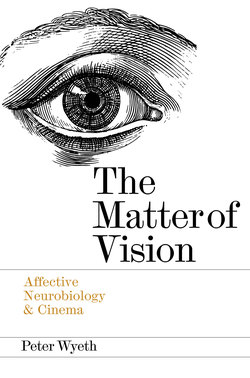Читать книгу The Matter of Vision - Peter Wyeth - Страница 11
На сайте Литреса книга снята с продажи.
The Automatic
ОглавлениеI would see it as another instance of Logocentrism that the area beyond Consciousness receives only the negative of the term as its title – unconscious. The terms suggest that Consciousness is the privileged one and its opposite number relatively unimportant and therefore deserves merely the negative term.
The information-processing numbers explored in the 1950s suggested Consciousness has a capacity of only around one-millionth of the area outside it – which we know as the unconscious. In proposing the term The Automatic, I want to draw attention to the notion that this area beyond Consciousness gets on with its many tasks outside our awareness, in silence as it were, and automatically – that is without conscious direction from us.23 The area appears to be substantial and neuroscientists often refer to the relevant processes as automatic, so that the term is already in current if informal use.
The comparison William James is said to have made between the conscious and Automatic as a pin in the Albert Hall gives an image of the difference of scale between the two, in which case Man is arguably an unconscious creature.
One of the main ideas behind this project was that we take in most of what we absorb from a film unconsciously/Automatically. Film-study could make a contribution to the understanding of the brain through helping to devise experiments that use films to assess what information audiences do in fact absorb Automatically. The difficulty is how to untangle information absorbed Consciously and that taken in Automatically.24 While there has been much work over the last twenty years on identifying the threshold between conscious and unconscious absorption, which has tended to suggest the extent of unconscious operations in the brain, there is a difference between crossing the threshold and, as it were, evaluating the building you are entering, between a first step and the universe beyond. Threshold analysis has certainly demonstrated the significance of emotion and the subjective, and that is congruent with the approach taken here towards Cinema. An advantage of working with films is that they can be viewed repeatedly, that is their output is a constant, and their content catalogued exhaustively to compare with audience recall in a variety of ways to find what works most effectively. Experiments with films have demonstrated differential brain activation, with a Hitchcock-directed TV film (Bang! You’re Dead, 1961), for example, scoring around 50% higher than The Good, The Bad & The Ugly. ‘Hitchcock was able to orchestrate the responses of so many different brain regions, turning them on and off at the same time across all viewers’.25 Even that rather basic experiment, using fMRI scanning (2008), provided evidence of the relation between mise-en-scene and attention, and between objective measurement of brain activity and the subjective experience of the audience.26
